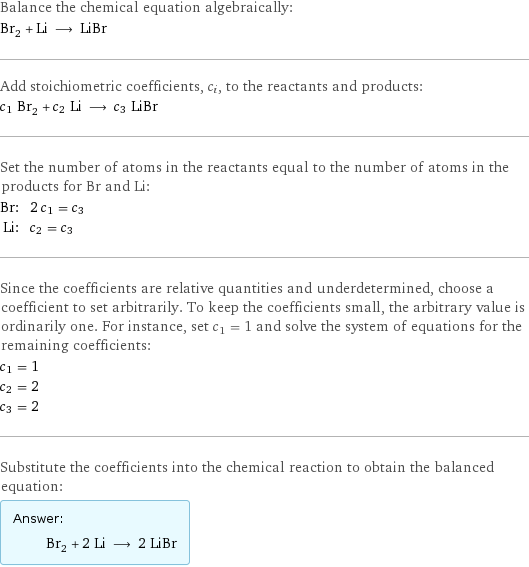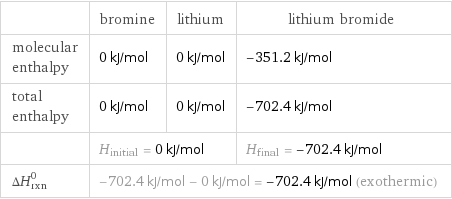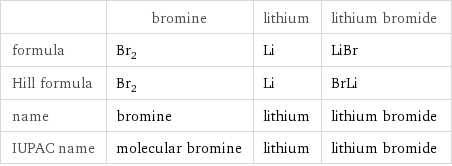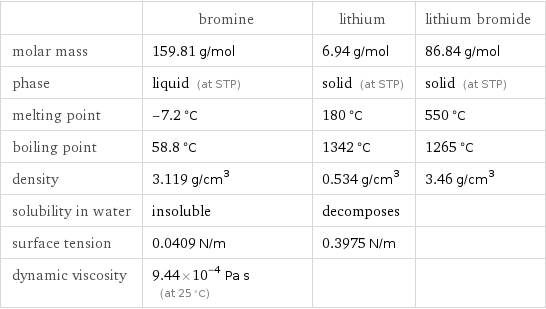Input interpretation

Br_2 bromine + Li lithium ⟶ LiBr lithium bromide
Balanced equation

Balance the chemical equation algebraically: Br_2 + Li ⟶ LiBr Add stoichiometric coefficients, c_i, to the reactants and products: c_1 Br_2 + c_2 Li ⟶ c_3 LiBr Set the number of atoms in the reactants equal to the number of atoms in the products for Br and Li: Br: | 2 c_1 = c_3 Li: | c_2 = c_3 Since the coefficients are relative quantities and underdetermined, choose a coefficient to set arbitrarily. To keep the coefficients small, the arbitrary value is ordinarily one. For instance, set c_1 = 1 and solve the system of equations for the remaining coefficients: c_1 = 1 c_2 = 2 c_3 = 2 Substitute the coefficients into the chemical reaction to obtain the balanced equation: Answer: | | Br_2 + 2 Li ⟶ 2 LiBr
Structures

+ ⟶
Names

bromine + lithium ⟶ lithium bromide
Reaction thermodynamics
Enthalpy

| bromine | lithium | lithium bromide molecular enthalpy | 0 kJ/mol | 0 kJ/mol | -351.2 kJ/mol total enthalpy | 0 kJ/mol | 0 kJ/mol | -702.4 kJ/mol | H_initial = 0 kJ/mol | | H_final = -702.4 kJ/mol ΔH_rxn^0 | -702.4 kJ/mol - 0 kJ/mol = -702.4 kJ/mol (exothermic) | |
Equilibrium constant
![Construct the equilibrium constant, K, expression for: Br_2 + Li ⟶ LiBr Plan: • Balance the chemical equation. • Determine the stoichiometric numbers. • Assemble the activity expression for each chemical species. • Use the activity expressions to build the equilibrium constant expression. Write the balanced chemical equation: Br_2 + 2 Li ⟶ 2 LiBr Assign stoichiometric numbers, ν_i, using the stoichiometric coefficients, c_i, from the balanced chemical equation in the following manner: ν_i = -c_i for reactants and ν_i = c_i for products: chemical species | c_i | ν_i Br_2 | 1 | -1 Li | 2 | -2 LiBr | 2 | 2 Assemble the activity expressions accounting for the state of matter and ν_i: chemical species | c_i | ν_i | activity expression Br_2 | 1 | -1 | ([Br2])^(-1) Li | 2 | -2 | ([Li])^(-2) LiBr | 2 | 2 | ([LiBr])^2 The equilibrium constant symbol in the concentration basis is: K_c Mulitply the activity expressions to arrive at the K_c expression: Answer: | | K_c = ([Br2])^(-1) ([Li])^(-2) ([LiBr])^2 = ([LiBr])^2/([Br2] ([Li])^2)](../image_source/ef4ac3d82a97e45bc8eee8e40c7b7e46.png)
Construct the equilibrium constant, K, expression for: Br_2 + Li ⟶ LiBr Plan: • Balance the chemical equation. • Determine the stoichiometric numbers. • Assemble the activity expression for each chemical species. • Use the activity expressions to build the equilibrium constant expression. Write the balanced chemical equation: Br_2 + 2 Li ⟶ 2 LiBr Assign stoichiometric numbers, ν_i, using the stoichiometric coefficients, c_i, from the balanced chemical equation in the following manner: ν_i = -c_i for reactants and ν_i = c_i for products: chemical species | c_i | ν_i Br_2 | 1 | -1 Li | 2 | -2 LiBr | 2 | 2 Assemble the activity expressions accounting for the state of matter and ν_i: chemical species | c_i | ν_i | activity expression Br_2 | 1 | -1 | ([Br2])^(-1) Li | 2 | -2 | ([Li])^(-2) LiBr | 2 | 2 | ([LiBr])^2 The equilibrium constant symbol in the concentration basis is: K_c Mulitply the activity expressions to arrive at the K_c expression: Answer: | | K_c = ([Br2])^(-1) ([Li])^(-2) ([LiBr])^2 = ([LiBr])^2/([Br2] ([Li])^2)
Rate of reaction
![Construct the rate of reaction expression for: Br_2 + Li ⟶ LiBr Plan: • Balance the chemical equation. • Determine the stoichiometric numbers. • Assemble the rate term for each chemical species. • Write the rate of reaction expression. Write the balanced chemical equation: Br_2 + 2 Li ⟶ 2 LiBr Assign stoichiometric numbers, ν_i, using the stoichiometric coefficients, c_i, from the balanced chemical equation in the following manner: ν_i = -c_i for reactants and ν_i = c_i for products: chemical species | c_i | ν_i Br_2 | 1 | -1 Li | 2 | -2 LiBr | 2 | 2 The rate term for each chemical species, B_i, is 1/ν_i(Δ[B_i])/(Δt) where [B_i] is the amount concentration and t is time: chemical species | c_i | ν_i | rate term Br_2 | 1 | -1 | -(Δ[Br2])/(Δt) Li | 2 | -2 | -1/2 (Δ[Li])/(Δt) LiBr | 2 | 2 | 1/2 (Δ[LiBr])/(Δt) (for infinitesimal rate of change, replace Δ with d) Set the rate terms equal to each other to arrive at the rate expression: Answer: | | rate = -(Δ[Br2])/(Δt) = -1/2 (Δ[Li])/(Δt) = 1/2 (Δ[LiBr])/(Δt) (assuming constant volume and no accumulation of intermediates or side products)](../image_source/b4f6e463587958f6974af2bca95fae21.png)
Construct the rate of reaction expression for: Br_2 + Li ⟶ LiBr Plan: • Balance the chemical equation. • Determine the stoichiometric numbers. • Assemble the rate term for each chemical species. • Write the rate of reaction expression. Write the balanced chemical equation: Br_2 + 2 Li ⟶ 2 LiBr Assign stoichiometric numbers, ν_i, using the stoichiometric coefficients, c_i, from the balanced chemical equation in the following manner: ν_i = -c_i for reactants and ν_i = c_i for products: chemical species | c_i | ν_i Br_2 | 1 | -1 Li | 2 | -2 LiBr | 2 | 2 The rate term for each chemical species, B_i, is 1/ν_i(Δ[B_i])/(Δt) where [B_i] is the amount concentration and t is time: chemical species | c_i | ν_i | rate term Br_2 | 1 | -1 | -(Δ[Br2])/(Δt) Li | 2 | -2 | -1/2 (Δ[Li])/(Δt) LiBr | 2 | 2 | 1/2 (Δ[LiBr])/(Δt) (for infinitesimal rate of change, replace Δ with d) Set the rate terms equal to each other to arrive at the rate expression: Answer: | | rate = -(Δ[Br2])/(Δt) = -1/2 (Δ[Li])/(Δt) = 1/2 (Δ[LiBr])/(Δt) (assuming constant volume and no accumulation of intermediates or side products)
Chemical names and formulas

| bromine | lithium | lithium bromide formula | Br_2 | Li | LiBr Hill formula | Br_2 | Li | BrLi name | bromine | lithium | lithium bromide IUPAC name | molecular bromine | lithium | lithium bromide
Substance properties

| bromine | lithium | lithium bromide molar mass | 159.81 g/mol | 6.94 g/mol | 86.84 g/mol phase | liquid (at STP) | solid (at STP) | solid (at STP) melting point | -7.2 °C | 180 °C | 550 °C boiling point | 58.8 °C | 1342 °C | 1265 °C density | 3.119 g/cm^3 | 0.534 g/cm^3 | 3.46 g/cm^3 solubility in water | insoluble | decomposes | surface tension | 0.0409 N/m | 0.3975 N/m | dynamic viscosity | 9.44×10^-4 Pa s (at 25 °C) | |
Units
